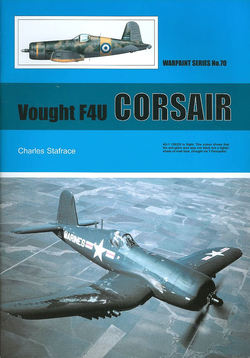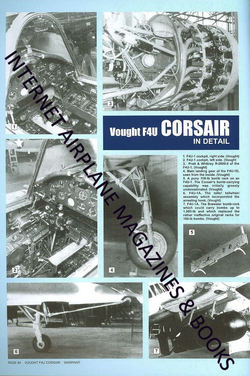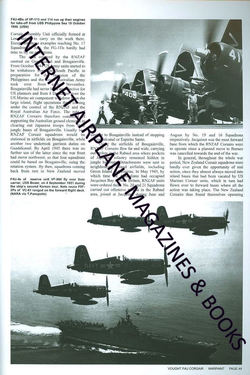WARPAINT 70 VOUGHT
F4U CORSAIR USN VF USMC VMF WW2 KOREA RN RNZAF AERONAVALE ARGENTINA
ALAN W. HALL WARPAINT SERIES
SOFTBOUND BOOK ***LIKE NEW
CONDITION*** 70 PAGES
FULL COLOR 4-VIEW SCALE DRAWINGS
INTRODUCTION
---------------------------------------------------------------------------------------------------------------------------
Additional Information from Internet Encyclopedia
The Chance
Vought F4U Corsair was an American fighter aircraft that saw service primarily
in World War II and the Korean War. Demand for the aircraft soon overwhelmed
Vought's manufacturing capability, resulting in production by Goodyear and
Brewster: Goodyear-built Corsairs were designated FG and Brewster-built aircraft F3A. From the first prototype delivery to the U.S. Navy in 1940,
to final delivery in 1953 to the French, 12,571 F4U Corsairs were manufactured
by Vought, in 16 separate models, in the longest production run of any
piston-engined fighter in U.S. history (1942–53).
The Corsair was designed as a carrier-based
aircraft. However its difficult carrier landing performance rendered the
Corsair unsuitable for Navy use until the carrier landing issues were overcome
when used by the British Fleet Air Arm. The Corsair thus came to and retained
prominence in its area of greatest deployment: land based use by the U.S.
Marines. The role of the dominant U.S. carrier based fighter in the second part
of the war was thus filled by the Grumman F6F Hellcat, powered by the same
Double Wasp engine first flown on the Corsair's first prototype in 1940. The
Corsair served to a lesser degree in the U.S. Navy. As well as the U.S. and
British use the Corsair was also used by the Royal New Zealand Air Force, the
French Navy Aeronavale and other, smaller, air forces until the 1960s. Some
Japanese pilots regarded it as the most formidable American fighter of World
War II and the U.S. Navy counted an 11:1 kill ratio with the F4U Corsair.
After the carrier landing issues had been tackled
it quickly became the most capable carrier-based fighter-bomber of World War
II. The Corsair served almost exclusively as a fighter-bomber throughout the
Korean War and during the French colonial wars in Indochina and Algeria.
The F4U incorporated the largest engine available
at the time: the 2,000 hp (1,500 kW) 18-cylinder Pratt & Whitney
R-2800 Double Wasp radial. To extract as much power as possible a relatively
large Hamilton Standard Hydromatic three-blade propeller of 13 feet
4 inches (4.06 m) was used.
Production F4U-1s featured several major
modifications compared with the XF4U-1. A change of armament to six
wing-mounted .50 in (12.7 mm) M2 Browning machine guns (three in each
outer wing panel) and their ammunition (400 rounds for the inner pair, 375 rounds
for the outer) meant that the location of the wing fuel tanks had to be
changed. In order to keep the fuel tank close to the center of gravity, the
only available position was in the forward fuselage, ahead of the cockpit.
Accordingly as a 237 gal (897 l) self-sealing fuel tank replaced the
fuselage mounted armament, the cockpit had to be moved back by 32 in
(810 mm) and the fuselage lengthened. In addition, 150 lb of armor
plate was installed, along with a 1.5 in (38 mm) bullet-proof windscreen
which was set internally, behind the curved Plexiglas windscreen. The canopy
could be jettisoned in an emergency, and half-elliptical planform transparent
panels, much like those of certain models of the Curtiss P-40, were inset into
the sides of the fuselage's turtledeck structure behind the pilot's headrest,
providing the pilot with a limited rear view over his shoulders. A rectangular
Plexiglas panel was inset into the lower center section to allow the pilot to
see directly beneath the aircraft and assist with deck landings. The engine
used was the more powerful R-2800-8 (B series) Double Wasp which produced
2,000 hp (1,491 kW). On the wings the flaps were changed to a NACA
slotted type and the ailerons were increased in span to increase the roll rate,
with a consequent reduction in flap span. IFF transponder equipment was fitted
in the rear fuselage. These changes increased the Corsair's weight by several
hundred pounds.
From February 1943 onward, the F4U operated from
Guadalcanal and ultimately other bases in the Solomon Islands. A dozen USMC
F4U-1s of VMF-124, commanded by Major William E. Gise, arrived at Henderson
Field (code name "Cactus") on 12 February. VMF-124 had produced the first Corsair ace,
Second Lieutenant Kenneth A. Walsh, who would rack up a total of 21 kills
during the war. Corsairs were flown by
the "Black Sheep" Squadron (VMF-214, led by Marine Major Gregory
"Pappy" Boyington) in an area of the Solomon Islands called "The
Slot". Other noted Corsair pilots of the period included VMF-124's Kenneth
Walsh, James E. Swett, and Archie Donohue, VMF-215's Robert M. Hanson and Don
Aldrich, and VF-17's Tommy Blackburn, Roger Hedrick, and Ira Kepford.














